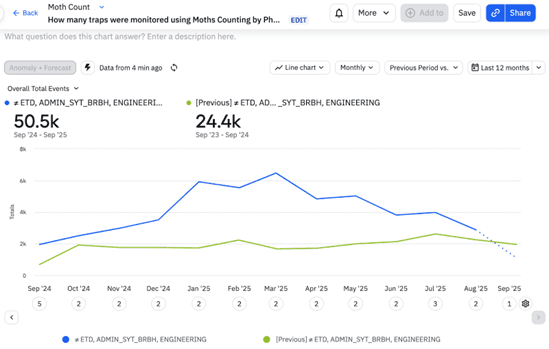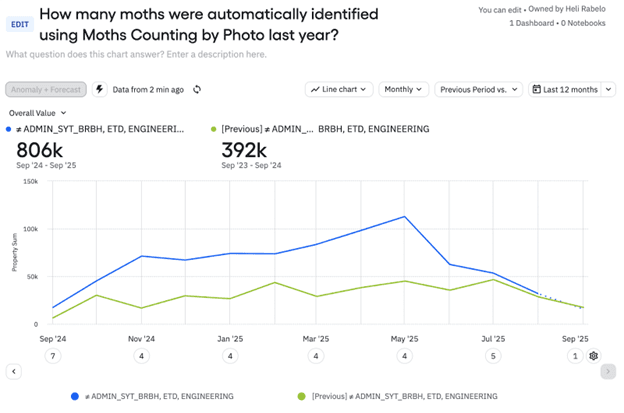How Syngenta Helps Farmers Grow Smarter While Growing Engagement 100% YoY
For global agriculture giant Syngenta, switching to Amplitude led to better data and better product decisions.
Insight/Action/Outcome: After the Digital Agriculture team at Syngenta launched an automated moth-counting feature for farmers, Amplitude data revealed that user adoption was below their target. However, a funnel analysis showed that users simply preferred manual counting in some situations, meaning their feature was already optimized for real-world usage patterns. The team shifted their approach to supporting both workflows seamlessly, and have seen 100% YoY engagement.
At Syngenta, a global leader in agriculture, our solutions help farmers in over 90 countries grow food more efficiently and sustainably. We are reinventing farming through technology, and our Cropwise family of solutions empowers growers to take data-driven action from planting to harvest.
As group product manager, I work cross-functionally with engineering, design, marketing, and business teams to identify the biggest opportunities to help our growers. We serve farmers of all sizes who grow various crops across different regions, so we have to balance global strategy with local market needs. All of this would be impossible without the insights into user behavior we’re able to get with Amplitude.
We were digging in poor soil
Finding success in new markets requires prioritizing feature development for specific users. Smallholders in southern Brazil have different needs than large-scale agriculture companies, with varying crops, farming practices, regulations, and technology adoption rates.
Prior to Amplitude, we were trying to use other tools for our analytics needs, but the results weren’t fruitful. We lacked critical user behavior data to measure product success, segment users, and target key markets. This data gap limited our ability to increase market penetration and improve customer lifetime value, both of which are key business objectives.
At the same time, our global product team was trying to standardize processes, including tracking events, gauging user adoption, creating user guides, and collecting direct customer feedback. This was hard to do with our previous partner, which we were using for app communications already, as it was costly and offered only high-level analytics. It also had issues duplicating guides and surveys across languages and locations.
With renewal approaching and a product rebuild in the works, it was the perfect time to secure a more comprehensive analytics solution.
Planting the seed for more reliable data
After getting some demos and researching our options, Amplitude stood out as the most complete, user-friendly, and scalable platform. It was more reliable and cost-effective than the existing tool, and since we already used Amplitude in our commercial solutions, like our Cropwise app suite, all we had to do was install a new SDK, confident that our data would remain secure and fully compliant with global privacy regulations. The willingness of the Amplitude team to partner with us on their new Guides and Surveys feature sealed the deal.
Amplitude has become essential to my day-to-day work. Whether I’m analyzing feature adoption, segmenting users, or identifying journeys and bottlenecks, Amplitude provides the answers I need to make good decisions.
Whether I’m analyzing feature adoption, segmenting users, or identifying journeys and bottlenecks, Amplitude provides the answers I need to make good decisions.
We started using Amplitude for Cropwise Protector, our biggest product in Brazil, and have since expanded it to cover our other Cropwise products. We have a saying, “Adoption is king,” and we’re pleased that Amplitude adoption has soared beyond the product team. We now have more than 250 weekly active users across design, engineering, customer success, and support teams sharing data to better understand customer behavior.
Amplitude’s support has been key to our adoption. They’ve been responsive and open to our suggestions, especially with Guides and Surveys. We now accompany every feature launch with a guide, and we have begun collecting user feedback for each of our Cropwise products. As beta adopters, it was incredible to participate actively in Amplitude’s development process, and they’ve remained receptive to our feedback now well past the general launch.
Improving how we track and think about product health
Amplitude also helps with new feature launches. Our main success metric for a product feature is the number of users or organizations who take a critical action, such as the number of scouting routes generated by a field technician or team to monitor a field, or the number of applications made based on control strategy suggestions. And similarly, it can also be valuable to know when users don’t take these actions. Amplitude’s alerts feature has become our early warning system, automatically detecting anomalies and notifying us of unexpected behavior before it becomes a bigger problem.
Amplitude’s alerts feature has become our early warning system, automatically detecting anomalies and notifying us of unexpected behavior before it becomes a bigger problem.
One example is Cropwise Protector’s Moth Counting feature. Moths are a common sugar cane pest, so cane farmers need to keep tabs on how many moths are in their fields with moth traps. Normally, technicians have to go into the fields and manually count the number of moths in the traps. Our new feature’s image recognition model automated the process by counting moths from a photo of a trap, saving hours of tedious bug counting.
We initially expected 80% adoption of the Moth Counting feature, but we discovered through Amplitude that users only adopted the new feature about 50% of the time. Funnel analysis showed that manual counting was simply faster when farmers found very few moths in their traps.

Rather than viewing this as a problem to fix, we realized our solution was already optimized for real-world usage patterns. Users naturally chose the most efficient method based on their specific conditions. We shifted our approach from trying to force 100% automated usage to instead supporting both workflows seamlessly. The key success metric isn’t just raw usage numbers, but that users are efficiently choosing the right tool for each situation—exactly what good product design should enable.
Year over year, there are now 100% more traps scouted with our tool and 100% more moths counted. User engagement continues to grow consistently, which validates our choice.

Amplitude helps us track the health of our models, too. At one point, we noticed that users were editing around 10% of the photos taken with this feature by adding or removing moths that were not correctly captured. This triggered an action for our Computational Agronomy team to review and update the neural network and upgrade the model. To allow the team to quickly investigate if model issues happen again, we also set up an alert for if performance drops below 90%.
Reaping what we sow
We were in the dark before, but Amplitude has shed light on everything related to our product. The platform is one of our most important tools, guaranteeing we work from the right data to move our business forward. With the help of Amplitude and other initiatives, Syngenta aims to reduce churn by 50% over the coming year.
Amplitude also helps us boost our growers’ success. Increasingly, our products assist our growers in increasing yields, reducing costs, and improving sustainability by reliably providing the accurate data they need to make the right decisions.
We were in the dark before, and Amplitude has shed light on everything. The platform is one of our most important tools, guaranteeing we work from the right data to move the business forward.
The future of farming is data-driven, and we are sowing the seeds for it. As we continue to find new use cases and expand our partnership with Amplitude, we are confident that we can better serve our growers and help shape the future of agriculture.

Heli Rabelo
Group Product Manager, Syngenta Digital Brasil
Heli is a a Product Manager at Syngenta Digital, where he works on the ideation and development of digital solutions for agriculture. With a degree in Control and Automation Engineering, he has experience in PIMS systems, data analysis, control systems, and agile methodologies.
More from HeliRecommended Reading

Stop Asking, Start Listening: How to Connect Feedback to Behavior
Dec 19, 2025
12 min read

Web Vitals in Amplitude: Understand and Optimize Web Performance
Dec 18, 2025
5 min read

Making Diagnostic Analytics Trustworthy
Dec 18, 2025
7 min read

The Product Benchmarks Every Retail and Ecommerce Company Should Know
Dec 18, 2025
5 min read

